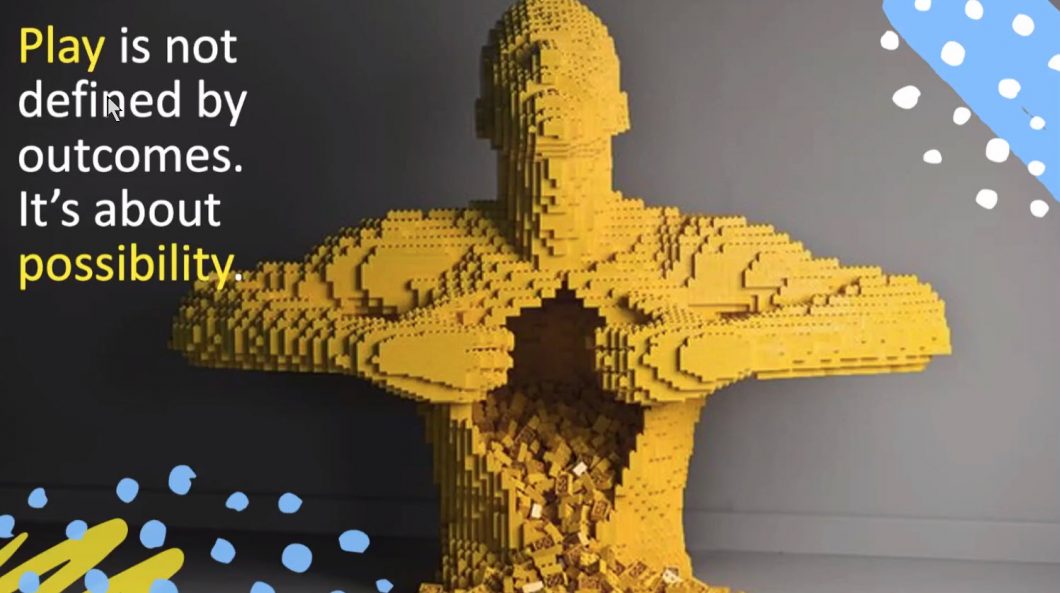1. Technology and learning culture – Nigel Paine
Nigel (nigelpaine.com) took us through a range of theories to explain that learning ecosystems are not just about technology, but also about people, content, data and governance. He said: “The density of connection between people is what makes an organisation knowledgeable.” We need people’s engagement and commitment and a stronger focus on social learning, not formal learning. We need people to think and learn from errors, learn to survive in complex societies and work on problems together. Technology is too often seen as the solution. Technology should not lead learning but enable it!
2. Play in the workplace – Danny Ginsberg
This presentation from Danny (culturehero.co) was to my heart: why we should use more play in the workplace. One of the reasons is that we learn more about each other in one hour of play than in a week of work. Play is also at the heart of the five essential skills the workforce values most: adaptability, creativity, emotional intelligence, collaboration and persuasion. People are at their best when they feel safe to be themselves, so don’t say “Let’s now do a bit of play”, but let play be part of your workplace culture. Invite people to play and let them experience that play is about possibility and not so much defined by outcomes.3. Leading with purpose – Dan Pontefract
Dan (danpontefract.com)described purpose as a balancing act between life and work, and you and your role. It’s about operating with a sense of meaning. There’s a three-way relationship to purpose: personal, role and organisational. We should ask ourselves a range of questions: does our organization operate with a sense of purpose and do we feel a connection? Who do you serve in your role in L&D and what difference can you make? And, what is our personal purpose: “How do you want to be known if you leave the room?’”. Let’s create value, deliver value, feel valued and be valuable!
4. Variable rewards – Andrew Bloye
Andrew (www.clearxp.com) talked about the three types of variable rewards: for the tribe, for the hunt and for self. Rewards for the tribe are the social awards. In learning, this could be earning points for social learning, for adding content and for being valued by peers for your contribution. The rewards for the hunt are the satisfaction from searching for content or being curious about what’s coming up next. In learning, this type of reward can be created by ‘treasure hunts’ for information, e.g. searching the intranet and answering questions. The third reward for self is about trying to reach a certain level, and the uncertainty if you’ll be able to reach it. In learning, the reward follows the completing of learning and/or earning a learning badge for completion. So, also without gamification, we can add elements of reward to learning.5. Universal Design for Learning (UDL) – Kerry Johnson
Kerry (www.unisa.edu.au) took us through the UDL framework, which is about inclusion in learning. It’s about minimising barriers to maximise learning. The guidelines provide suggestions on how to make learning better for all, with tips for engagement, representation and action and expression. The framework is broader than accessibility guidelines and useful for all types of learning. Quick wins are, for example, explaining a diagram in text, providing different types of activities so learners have a choice and more showing than telling.And there was so much more
I also attended a great session about’ showing up’ and the value of co-mentoring from Tony Sloman and Michelle Ockers, listened to Tanya Tytherleigh with great tips for a better welcome to new team members and Cheryle Walker about online facilitation. Rachel Service talked about world-class learning cultures and Stacey Edmonds finished the conference by taking us live through new ways of learning and challenged us to shift our thinking about what learning is!Blown away
I said earlier that we were blown away by the presentations. Anneli Blundell and Dan Pontefract both had their slides in the background and used the latest technology and all the tricks from the ‘facilitation handbook’ to engage us. Shine Lawyers used custom-made videoclips in the same cartoon style as the elearning module they were talking about to break up the dialogue. It shows again that there’s no ‘death by PowerPoint’ and online learning can be very, very engaging.
Of course, this is only a snapshot of what was offered at the AITD conference this year. Another benefit of online conferences is that we can watch the recordings of all the sessions that we’ve missed during another rainy weekend. So, I think I’ll extend my conference with another day of happy learning!

